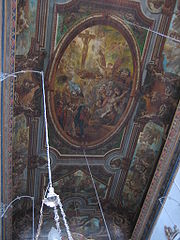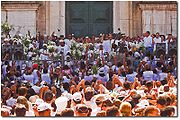
Church of Nosso Senhor do Bonfim (Salvador)
Encyclopedia

Catholic
The word catholic comes from the Greek phrase , meaning "on the whole," "according to the whole" or "in general", and is a combination of the Greek words meaning "about" and meaning "whole"...
churches of Salvador, in the State of Bahia, Brazil
Brazil
Brazil , officially the Federative Republic of Brazil , is the largest country in South America. It is the world's fifth largest country, both by geographical area and by population with over 192 million people...
. It was built in the 18th century on a hill in the Itapagipe peninsula, in the lower town of Salvador. The church is the subject of intense religious devotion by the people of Salvador and is the site of a famous celebration held every year in January (Festa do Senhor do Bonfim).
The church is the Cathedral of the Roman Catholic Diocese of Bonfim
Roman Catholic Diocese of Bonfim
The Roman Catholic Diocese of Bonfim is a diocese located in the city of Salvador, Bahia, in the Ecclesiastical province of Feira de Santana in Brazil.-History:...
.
History
The veneration of Nosso Senhor do Bonfim (Our Lord of the Good End, represented by the crucified JesusJesus
Jesus of Nazareth , commonly referred to as Jesus Christ or simply as Jesus or Christ, is the central figure of Christianity...
in the moment of his death) is an old tradition in Portugal
Portugal
Portugal , officially the Portuguese Republic is a country situated in southwestern Europe on the Iberian Peninsula. Portugal is the westernmost country of Europe, and is bordered by the Atlantic Ocean to the West and South and by Spain to the North and East. The Atlantic archipelagos of the...
that was imported to Brazil during colonial times
Colonial Brazil
In the history of Brazil, Colonial Brazil, officially the Viceroyalty of Brazil comprises the period from 1500, with the arrival of the Portuguese, until 1815, when Brazil was elevated to kingdom alongside Portugal as the United Kingdom of Portugal, Brazil and the Algarves.During the over 300 years...
. In 1740, in order to fulfill a vow, Portuguese captain Teodósio Rodrigues de Faria brought a statue of Nosso Senhor do Bonfim from Setúbal
Setúbal
Setúbal is the main city in Setúbal Municipality in Portugal with a total area of 172.0 km² and a total population of 118,696 inhabitants in the municipality. The city proper has 89,303 inhabitants....
(Portugal) to Salvador. Some years later a religious brotherhood (irmandade) dedicated to Our Lord of Bonfim was founded and a church to house the statue - the current Church of Nosso Senhor do Bonfim - began being built on top of Montserrat hill, in the Itapagipe peninsula, in the lower town of Salvador. The church was inaugurated in 1754, with the towers being finished around 1772.
The façade of the church is two-dimensional, with a central body flanked by two towers. The windows and specially the elaborate volute
Volute
A volute is a spiral scroll-like ornament that forms the basis of the Ionic order, found in the capital of the Ionic column. It was later incorporated into Corinthian order and Composite column capitals...
s of the gable
Gable
A gable is the generally triangular portion of a wall between the edges of a sloping roof. The shape of the gable and how it is detailed depends on the structural system being used and aesthetic concerns. Thus the type of roof enclosing the volume dictates the shape of the gable...
on top of the façade follow a Rococo
Rococo
Rococo , also referred to as "Late Baroque", is an 18th-century style which developed as Baroque artists gave up their symmetry and became increasingly ornate, florid, and playful...
(late Baroque
Baroque
The Baroque is a period and the style that used exaggerated motion and clear, easily interpreted detail to produce drama, tension, exuberance, and grandeur in sculpture, painting, literature, dance, and music...
) design. The lower parts of the façade were covered by Portuguese white tiles (azulejo
Azulejo
Azulejo from the Arabic word Zellige زليج is a form of Portuguese or Spanish painted, tin-glazed, ceramic tilework. They have become a typical aspect of Portuguese culture, having been produced without interruption for five centuries...
s) in 1873.

Neoclassicism
Neoclassicism is the name given to Western movements in the decorative and visual arts, literature, theatre, music, and architecture that draw inspiration from the "classical" art and culture of Ancient Greece or Ancient Rome...
main altarpiece, which has the form of a baldachin
Baldachin
A baldachin, or baldaquin , is a canopy of state over an altar or throne. It had its beginnings as a cloth canopy, but in other cases it is a sturdy, permanent architectural feature, particularly over high altars in cathedrals, where such a structure is more correctly called a ciborium when it is...
with a cupola sustained by volutes, was carved and probably also designed by sculptor Antônio Joaquim dos Santos between 1813 and 1814. The lateral walls of the single-aisle
Aisle
An aisle is, in general, a space for walking with rows of seats on both sides or with rows of seats on one side and a wall on the other...
d nave
Nave
In Romanesque and Gothic Christian abbey, cathedral basilica and church architecture, the nave is the central approach to the high altar, the main body of the church. "Nave" was probably suggested by the keel shape of its vaulting...
are decorated with several altarpieces.
Another notable feature of the church is the painted wooden ceiling, executed by Bahia artist Franco Velasco between 1818 and 1820, which shows people thanking Our Lord of Bonfim for having survived a shipwreck
Shipwreck
A shipwreck is what remains of a ship that has wrecked, either sunk or beached. Whatever the cause, a sunken ship or a wrecked ship is a physical example of the event: this explains why the two concepts are often overlapping in English....
. The sacristy
Sacristy
A sacristy is a room for keeping vestments and other church furnishings, sacred vessels, and parish records.The sacristy is usually located inside the church, but in some cases it is an annex or separate building...
, nave and other rooms of the church display paintings by another notable Bahia painter, José Teófilo de Jesus, executed in the 1830s.
In the 19th century, the Bonfim Brotherhood built houses in the square in front of the church to house the pilgrim
Pilgrim
A pilgrim is a traveler who is on a journey to a holy place. Typically, this is a physical journeying to some place of special significance to the adherent of a particular religious belief system...
s (romeiros) that come to Salvador every year to honour Our Lord of Bonfim.
Festa do Bonfim
The Festa do Bonfim (Feast of Bonfim) is one of the most important annual popular celebrations in Salvador, starting on the second Thursday after Three Kings Day (January 6). On this Thursday, the faithful gather in front of the Church of Conceição da Praia, in downtown Salvador (Baixa), including a large group of Bahia ladies (bahianas) in traditional white costume, with turbants and long, round skirts. After mass, the faithful take part on a processionProcession
A procession is an organized body of people advancing in a formal or ceremonial manner.-Procession elements:...
that leaves the Church of Conceição da Praia and, after an 8-km course, reaches the hill of the Bonfim Church. Upon reaching the top, the bahianas wash the steps and the square (adro) in front of the church with aromatised water while dancing and singing chants in Yoruba language
Yoruba language
Yorùbá is a Niger–Congo language spoken in West Africa by approximately 20 million speakers. The native tongue of the Yoruba people, it is spoken, among other languages, in Nigeria, Benin, and Togo and in communities in other parts of Africa, Europe and the Americas...
. The washing ritual is called the Lavagem do Bonfim (Washing of Bonfim) and attracts a multitude of believers as well as tourists.

Mass
Mass can be defined as a quantitive measure of the resistance an object has to change in its velocity.In physics, mass commonly refers to any of the following three properties of matter, which have been shown experimentally to be equivalent:...
in the Bonfim Church. Many worshippers come from far away to honour vow
Vow
A vow is a promise or oath.-Marriage vows:Marriage vows are binding promises each partner in a couple makes to the other during a wedding ceremony. Marriage customs have developed over history and keep changing as human society develops...
s taken with Our Lord of Bonfim. The church has a museum of ex-voto
Ex-voto
An ex-voto is a votive offering to a saint or divinity. It is given in fulfillment of a vow or in gratitude or devotion...
s brought by the worshippers in gratitude after receiving a divine grace
Divine grace
In Christian theology, grace is God’s gift of God’s self to humankind. It is understood by Christians to be a spontaneous gift from God to man - "generous, free and totally unexpected and undeserved" - that takes the form of divine favour, love and clemency. It is an attribute of God that is most...
. The feast includes stands serving traditional food, souvenirs, traditional dances and concerts by local musical groups.
Even though the feast is Catholic
Catholic
The word catholic comes from the Greek phrase , meaning "on the whole," "according to the whole" or "in general", and is a combination of the Greek words meaning "about" and meaning "whole"...
in its origins, it also reveals much about the religious syncretism
Syncretism
Syncretism is the combining of different beliefs, often while melding practices of various schools of thought. The term means "combining", but see below for the origin of the word...
between Catholicism and African religions in Bahia. In the Candomblé
Candomblé
Candomblé is an African-originated or Afro-Brazilian religion, practised chiefly in Brazil by the "povo de santo" . It originated in the cities of Salvador, the capital of Bahia and Cachoeira, at the time one of the main commercial crossroads for the distribution of products and slave trade to...
religion, Our Lord of Bonfim is associated with Oxalá, father of the Orishas and creator of humankind. Indeed, people dress in white during the feast to honour Oxalá.

